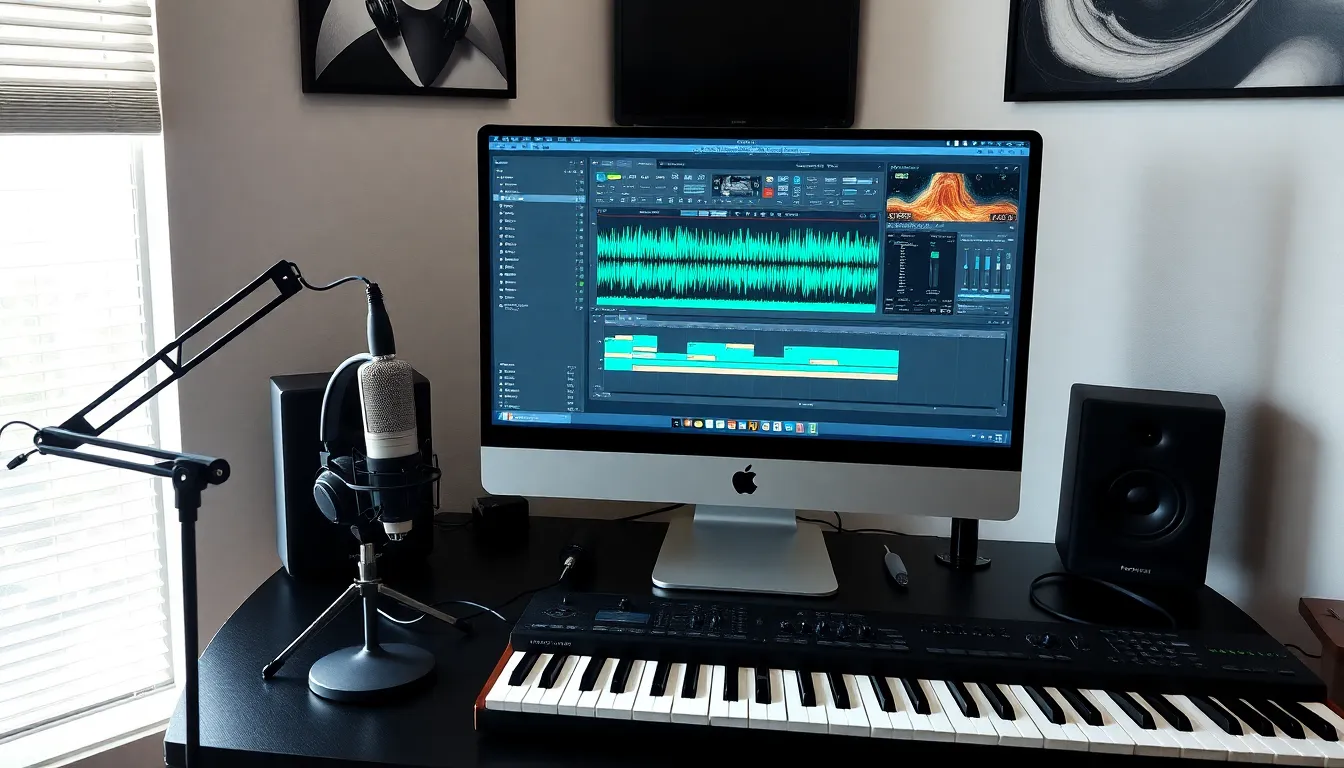In a world where music creation is just a click away, digital audio workstations (DAWs) have become the secret weapon of musicians, producers, and audio enthusiasts alike. Imagine having a fully equipped recording studio right on your laptop. It’s like having a magic wand that turns ideas into chart-topping hits—without the need for a full band or a million-dollar studio.
Table of Contents
ToggleOverview of Digital Audio Workstations
Digital audio workstations (DAWs) serve as vital tools for music creation, providing an integrated environment for recording, editing, mixing, and producing audio. Users can manipulate audio tracks on a timeline, allowing for precise placement and timing adjustments. Many DAWs come equipped with virtual instruments and effects, enhancing the creative process without needing additional hardware.
Key features of DAWs often include multi-track recording capabilities, audio editing functionalities, and MIDI support. Many DAWs allow for real-time monitoring, which improves workflow and helps artists capture their ideas efficiently. Producers can collaborate seamlessly using cloud functionality, streamlining communication and project sharing.
Common options in the DAW market include industry standards like Ableton Live, Logic Pro, and Pro Tools. Each option offers unique interfaces and features, catering to different user preferences and workflow styles. Understanding these options empowers users to choose the right DAW that aligns with their creative requirements.
Additionally, many DAWs support third-party plugins, granting access to a vast array of virtual instruments and sound libraries. Artists benefit from these resources while expanding their sonic palette and enhancing the overall quality of their productions. DAWs also offer automation features, allowing users to fine-tune sound dynamics and create intricate soundscapes.
Digital audio workstations are not just for professionals; many beginner-friendly options exist, helping newcomers learn essential audio production skills. This wide range of tools and functionalities makes DAWs indispensable in today’s music production landscape. Through DAWs, creators can transform their artistic visions into reality, pushing the boundaries of audio innovation.
Key Features of Digital Audio Workstations

Digital audio workstations (DAWs) offer numerous features for music creation and production. These capabilities enhance the user experience and streamline the process of turning ideas into polished tracks.
Recording Capabilities
Recording capabilities within DAWs allow for multi-track recording. Artists can capture multiple audio sources simultaneously. Additionally, virtual instruments can be integrated easily, giving musicians flexibility. Most DAWs support high-quality audio formats, ensuring professional results. Real-time input monitoring enables artists to hear what they are recording without noticeable delay. As a result, users enjoy an efficient recording process, minimizing missed takes and maximizing creativity.
Editing Tools
Editing tools in DAWs streamline the audio manipulation process. Users can cut, copy, and paste audio segments with just a few clicks. Many DAWs offer advanced features like time-stretching and pitch correction for precise adjustments. Users benefit from waveform editing, which displays audio visually, making it easier to edit accurately. Automation lanes allow for dynamic changes in volume and effects during playback. These editing capabilities make fine-tuning recordings simple and efficient.
Mixing Interfaces
Mixing interfaces provide a user-friendly environment for balancing audio tracks. Each DAW typically includes a virtual mixer with faders for volume control. Pan controls enable users to place sounds within the stereo field, creating a more immersive experience. Moreover, built-in effects such as EQ and compression assist in shaping sound. Users can also organize tracks into groups, simplifying complex sessions. This level of control contributes to polished final mixes, essential in professional audio production.
Popular Digital Audio Workstation Software
Several digital audio workstations stand out in the industry, each offering unique features tailored to different needs. Here are three popular options:
Ableton Live
Ableton Live ranks as a top choice for electronic music producers and live performers. This software supports real-time audio manipulation, allowing users to improvise during performances. Its Session View facilitates the arrangement and triggering of clips, while extensive MIDI capabilities enhance creativity. Flexible audio recording options make it suitable for both studio and stage work. Several built-in instruments and effects expand its sound design potential, simplifying the production process.
Logic Pro
Logic Pro serves as a comprehensive tool for Mac users focused on music production. With a vast library of sounds and loops, it provides ample resources for crafting tracks across genres. MIDI editing features excel in precision, enabling detailed adjustments to melodies and rhythms. Users benefit from a robust mixing interface, complete with visual feedback on levels and effects. Integrated plugins and virtual instruments enhance the creative workflow, making it a go-to DAW for many professionals.
Pro Tools
Pro Tools remains a benchmark for professional audio recording and editing. This software offers advanced capabilities for multi-track recording, ensuring clarity and detail in audio projects. Its editing tools include powerful waveform manipulation features, facilitating precision adjustments. Users appreciate the wide range of third-party plugin support, which broadens their creative options. Collaboration features streamline workflows in studio settings, making Pro Tools an industry standard for audio engineers and producers alike.
Choosing the Right Digital Audio Workstation
Selecting a digital audio workstation (DAW) requires thoughtful consideration of individual needs and preferences. Users find varying features appeal to different skill levels and production styles.
Considerations for Beginners
Beginners often look for simplicity and ease of use. They benefit from DAWs that offer intuitive interfaces and essential features to get started. Options like GarageBand present straightforward layouts while providing crucial tools for music creation. Accessibility aids new users in comfortably learning audio production. User-friendly tutorial resources enhance the learning experience, allowing them to grasp fundamental concepts quickly. Additionally, affordability plays a critical role, as many entry-level DAWs provide essential capabilities without high initial investment.
Features for Advanced Users
Advanced users typically seek robust features that foster creativity and streamline workflow. Multi-track recording capabilities allow for seamless layering of instruments and vocals. Tools for MIDI editing and audio manipulation enable intricate adjustments and enhancements. Professional-grade mixing interfaces improve control over sound dynamics, offering virtual mixers and advanced effects. DAWs that support third-party plugins expand the range of available sounds and instruments. Collaboration features increase efficiency for team projects, facilitating real-time communication and file sharing among users. Artists expect continued innovation, making regular software updates and new features essential in meeting their evolving production needs.
Digital audio workstations have revolutionized music production by making it accessible to anyone with a creative spark. Their integrated features empower users to record edit and mix with unprecedented ease and flexibility. As technology continues to evolve DAWs are likely to become even more sophisticated offering new tools and capabilities that inspire innovation.
Whether one is a seasoned professional or just starting out the right DAW can significantly enhance the creative process. With a variety of options available artists can find the perfect fit for their unique workflow and musical style. Embracing these powerful tools not only fosters creativity but also paves the way for the future of audio production.

